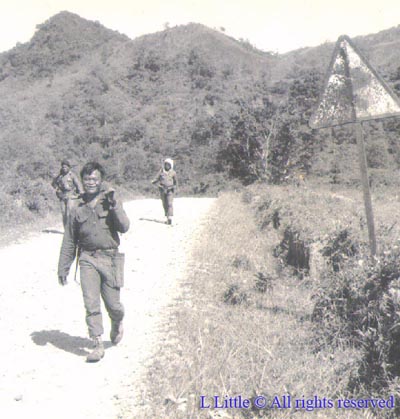|
Quang
Ngai Province, Ba To district
15° 43' N -
108° 05'E AT879396 or 81483834
GIA-VUC
CIDG camp,
I CTZ - South Vietnam
Camp
Gia-Vuc was one of the oldest SF camps in the 1st CORPS It was
an old French camp (Indochina War) reopened by USSF in February 1963, A-5/1,
to secure a population of 1500 HRE montagnards
and about 300
Vietnamese in that area. The camp was situated near the Song Re
river in the Quang Ngai province, about 80 miles from Danang and
was originally in the II CORPS Tactical Zone. In in 1964, the I
and II CTZ borders were adjusted and the camp came under control
of the I CTZ. Gia -Vuc was the southernmost camp in the 1st CTZ
and its mission was surveillance and interdiction on
infiltration routes.
The Song Re valley know as Vietcong Valley
was one of the major enemy supply/infiltration routes
from Laos
Eastwards to the Vietnamese costal lowlands.
It is believed
that Gia-Vuc made a lot of Civic Action progress and
improvements in the area
and encountered more than its fair
share of VC. When the camp was handed back to LLDB in 1969,
there were approximately 6400 Hre and Vietnamese living in the
area.
Gia-Vuc was also known as the "Shangrila" of
Vietnam and was becoming the social,
cultural and political
center of the Hre Montagnards.
Colonel Harold R Aaron referred
to Gia-Vuc as the most successful SF camp in Vietnam.
During
most of its life, the camp lacked artillery, but at some stage
had recoilless rifles to ward off
enemy attacks. The camp
defenses were virtually probed every night and suffered regular
mortar attacks. Later on, the fighting trenches were hardened
against mortar attacks by concrete capping of trenches and bunker system. Due to tropical
rain storms flooding was not uncommon.
***
"An interesting fact about Gia Vuc
is that, after it was turned over to the ARVN Rangers,
it was
besieged by PAVN as part of PAVN's invasion of RVN.
The Rangers
fought to the last man there, some 300 KIA or MIA.
" This
additional information is thanks to Alex
Humphrey (5th SFGA, Ba To 1964-65)
Imagine a green
valley, slightly long than wide. Weaving through the middle is
the Song Re river, running shallow over rocks
and rapids during
the dry season but fierce and often impossible to ford in the
rainy season.
The floor of the valley has the terrain of a
golf course, rolling into terraced rice paddies at the bottoms
of the mountains
ringing the valley. At one end of the
valley, far in the distance, a waterfall pours off the top of a
ridge, falling nearly
halfway to the bottom before losing itself
in the trees. Dozens of water buffalo graze near the
streams and ponds.
The fog and clouds roll and tumble and
slide up and down the mountains all day long...never remaining
stationary
for more than an hour. Suddenly half the entire
valley is invisible in misty white; 60 minutes later
only little
puffs float halfway up the hills. Over there, a long
skinny finger of fog flows down a long narrow valley, finally
wrapping itself around one of the hamlets and then curling
itself into a ball and floating away.
A dream world.
The Hre Montagnard villages perch clean and tiny on little
hills, looking like a child's story of fairy-tale houses in a
fairy-tale valley.
This is Gia Vuc, about 80 miles southwest of Danang and about
mid-way to Laos. The Special Forces camp is an old camp;
the minefields in front still have some French mines in them and
some of the Hre tribesmen speak a little French. The Hre are one
of the large subgroups of the Montagnards with an estimated
150,000 people. Most do not have the epicanthal eye fold,
and most have a straight though short nose, not the flatter nose
of most Vietnamese. Most adults (especially the older)
have had their front teeth either filed down or broken off, a
tribal custom.
A few French genes visible in some who have white
skin and some who have red hair.
Running through the middle of
our compound are bits and pieces of an old French road that once
linked Kontum and Quang Ngai.
"One day on patrol, I was
amazed to see an old highway sign, rusty and full of bullet
holes, that read "Kontum 25k."

Photo of CIDG's from Gia Vuc, due to their relax look, they must be closed to the camp
(note the old French road sign) Photo, thanks to Loyd Little, A-113, 1965
Rice is the primary crop although tea, coconuts, cinnamon,
honey, hemp and areca palm are grown. Growing wild are bananas,
sugar cane, mangoes and a grapefruit-like plant. A typical
hamlet has 50-60 people in 12-18 huts perched on hills.
Favorite
drink is a quite potent rice wine.
Altogether about 1,000
Hre live in this one long valley. There is only one school
in the valley, and it was built by an earlier SF team.
A
teacher was recruited from Saigon and was paid by SF.
Hre have been fighting since the early 1950s, some with the
French, some with the Viet Minh/Viet Cong.
Our housegirl was a captured Viet Cong and recruited (we think) to our side.
Description of Gia
Vuc is thanks to Loyd Little Sr Medic (E-6) at Gia Vuc
(A-113 Sept. 8 to Nov. 2, 1965)

|
Steve Sherman the
archivist for
the Special Forces and Special Operations Associations
Need your help! |

|